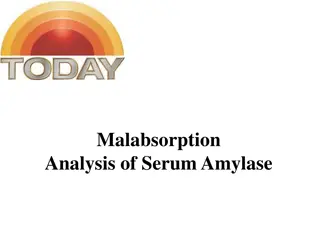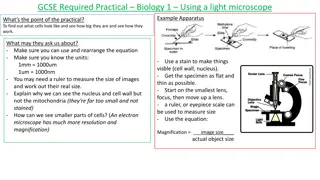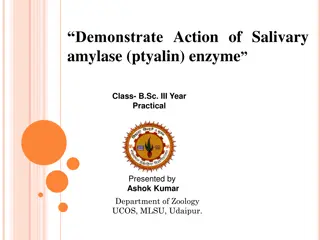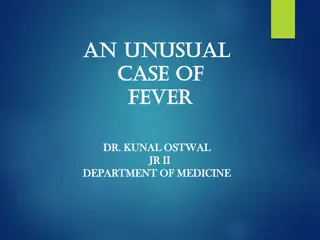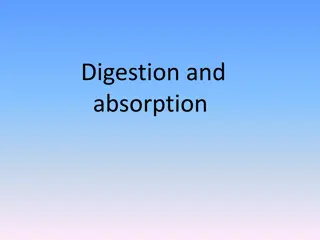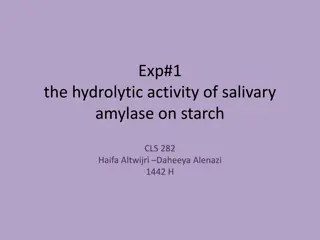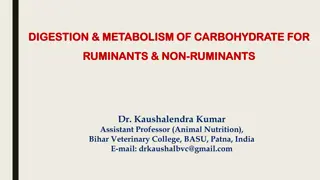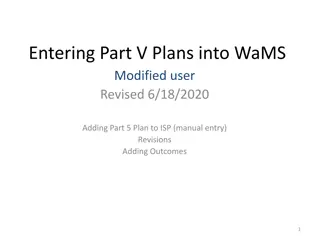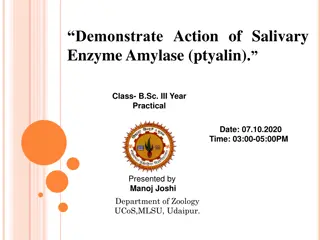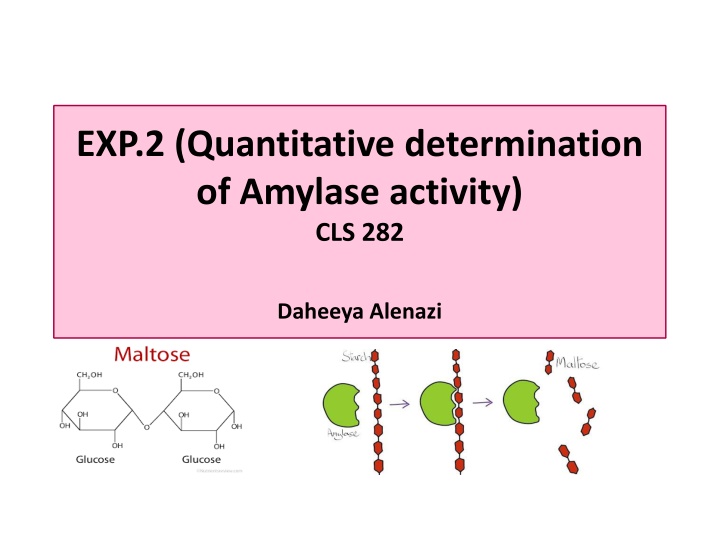
Amylase Activity Quantification Experiment
Learn how to determine the activity of amylase enzyme by estimating the amount of maltose produced and constructing a standard curve. The experiment involves measuring absorbance, creating a maltose standard curve, and calculating concentrations.
Download Presentation

Please find below an Image/Link to download the presentation.
The content on the website is provided AS IS for your information and personal use only. It may not be sold, licensed, or shared on other websites without obtaining consent from the author. If you encounter any issues during the download, it is possible that the publisher has removed the file from their server.
You are allowed to download the files provided on this website for personal or commercial use, subject to the condition that they are used lawfully. All files are the property of their respective owners.
The content on the website is provided AS IS for your information and personal use only. It may not be sold, licensed, or shared on other websites without obtaining consent from the author.
E N D
Presentation Transcript
EXP.2 (Quantitative determination of Amylase activity) CLS 282 Daheeya Alenazi
Introduction The purpose of this experiment is to study: To study the enzyme amylase which is found in saliva. Amylase breaks down starch into the maltose as the end product. To estimate the amount of maltose by using a standard curve.
Principle Starch react with iodine to give a blue color and maltose react with alkaline dinitrosalicylic acid to give an orange color. The former reaction is not stoichiometric (the intensity of blue color is not linearly proportional to starch conc. And it is only qualitative value) The maltose assay on other hand is stoichiometric and is used to estimate the amount of maltose formed . A standard curve for maltose constructed for working out the result
Beer's law states that the absorbance is directly proportional to the concentration of a solution. If you plot absorbance versus concentration, the resulting graph yields a straight line. C1 V1 = C2 V2 (Start reading) (final reading) http://t0.gstatic.com/images?q=tbn:ANd9GcQXWj-KZCOdHi4kTKz7ujFdWQZjHEf3bCuZaR35TrTz5xwXH4FWic6YS8cj
Principle Amylase 1-StarchMaltose 2-Maltose + 3,5 dinitrosalicylic acid(Alkaline reagent) http://t1.gstatic.com/images?q=tbn:ANd9GcTlgWL_hBHeaLU2rCVxhyI_vvvkUav_ZWJoMIGfjfWz5QdloBE0Wtmb-xgq Red Orange colour
Procedure steps 1-Construction of Maltose standard curve: Use beer s low to measure standards of Maltose. 2-Measure of unknown of maltose: Compare results with standard curve. 3-Measure amount of Maltose formed per ml of saliva Using data from step 2
Part 1: Construction of maltose std. Curve: blank Std.1 Std.2 Std.3 Std.4 Maltose (1mg/ml) - 0.1 0.5 1.5 2 H2O DNS Rgt (ml) 2 ml 2 1.9 2 1.5 2 0.5 2 --- 2 10 mins., boiling water bath. And cool, 6 6 Read the Abs at 520 nm. H2O (ml) 6 6 6
Calculation of part 1 1-C1 V1 = C2 V2 : C1= 1 mg/ml V1=0.1,0.5,1.5,2 V2=2ml C2= ? 2-Create The Result Table. Read Abs. on 520 nm. 3-Draw The Curve
Spectrophotometer http://teaching.shu.ac.uk/hwb/chemistry/tutorials/molspec/beers1.htm
Reagents used 1-Alkaline reagent (1gm of 3,5 dinitrosalicylic acid )+ 1gm of sodium potassium tartarate + 30gm sodium hydroxide + 1L D .W) 2-1% Maltose 3-o.1M Phosphate buffer, PH=7 4-Buffered starch substrate. 5-1%NaCl 6-2N NaoH
Part (2): Measure unknown of Maltose Tube1 (Blank) Tube2 (Test) Tube3 (zero time control) Phosphate buffer 2.5 ml 2.5 ml 2.5 ml Starch solution 2.5 ml 2.5 ml 2.5 ml NaCl (1%) 1 1 1 Mix, incubate 10 mins at 37 c H2O ml 1 0.5 0.5 Diluted saliva (1:20) --- 0.5 0.5 NaOH ---- ---- 0.5 1&2 incubation15 mins, 37 c NaoH 0.5 0.5 ---- Reagent DNS 0.5 0.5 0.5 Mix, Heat In Boiling Water For 5 mins.Cool It at R.T Add 2 ml H2O,Read Abs at 520nm
Calculation steps A/calculate The Correct Absorbance =final Abs-initial Abs =Tube 2 Tube 3 then, B/Compare result with Maltose standard curve. (previous curve) C/Calculate the amount of Maltose formed per ml of saliva... ( Enzyme Activity)
Part(3):Measure amount of maltose formed by Saliva Amount of maltose formed in mg/min/1ml of saliva= X x Amount of saliva x 2 x Dilution factor x 1000 M.wt of maltose x Time X= Conc. of maltose Amount of saliva = 0.5 Dilution factor = 20 M.wt of maltose=342 g/mol Time=15 min

![❤[READ]❤ Robotic Exploration of the Solar System: Part I: The Golden Age 1957-19](/thumb/21623/read-robotic-exploration-of-the-solar-system-part-i-the-golden-age-1957-19.jpg)






